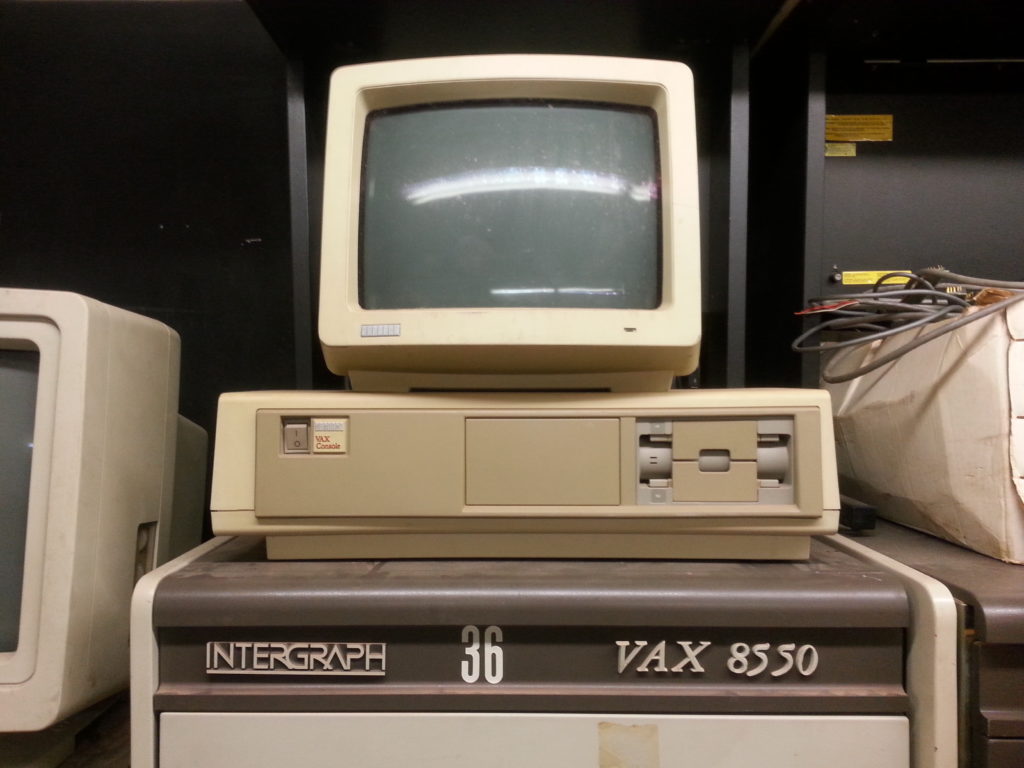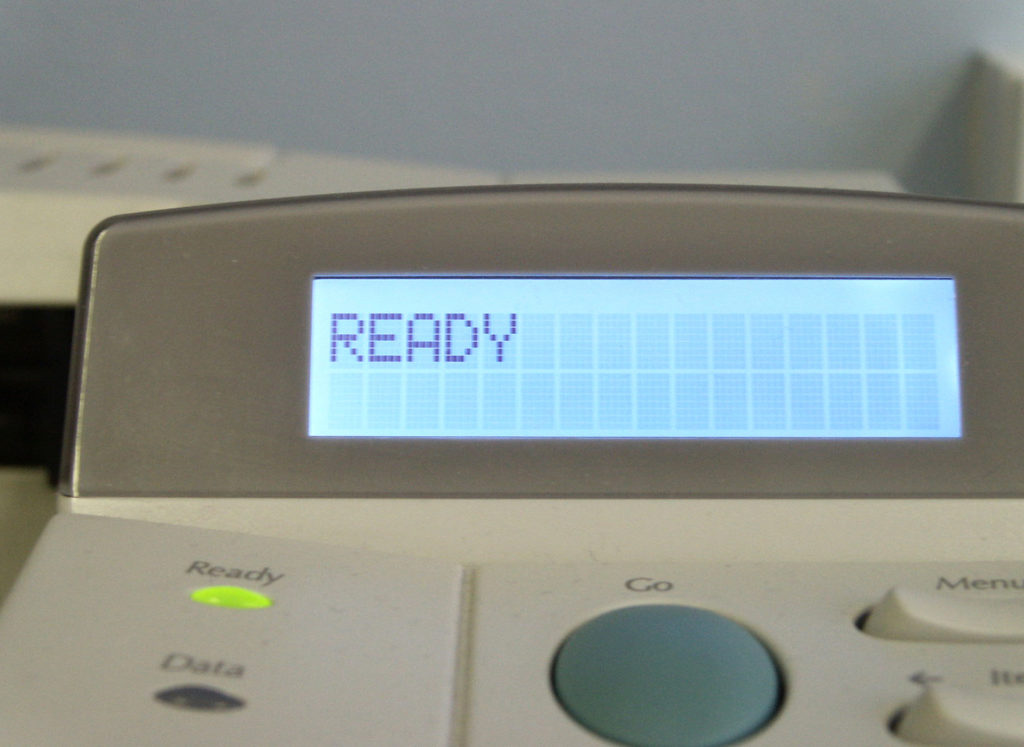Having recently changed jobs and become self-employed, I have a lot more spare time. What better way to spend it than getting an OpenVMS machines running on a Raspberry Pi.

These instructions are necessarily quick and make assumptions that you know what you’re doing. They’re also heavily influenced by this YouTube video, and I’m very grateful for the simple explanation of Linux bridge and tap interfaces.
The basics
I started by copying the 32-bit version of Ubuntu 18.04LTS for the Raspberry Pi 3 on to an SD card. Pop that in your Pi and boot up with an Ethernet cable connected and a DHCP server available. There’s no need to attach a keyboard or monitor – just ssh in to the server with username and password, and it’ll prompt you to change your password on first login.
Cloning the simh repository and installing dependencies is straightforward, and takes about four minutes in my Pi 3B+:
apt install make libsdl2-dev libpng-dev libpcap-dev libvdeplug-dev bridge-utils git clone https://github.com/simh/simh.git cd simh make -j4 vax8600
There are other targets you can build for, but we’re going to use the VAX 8600.
| Target | Simulator |
| microvax1 | MicroVAX I (KA610) |
| microvax2 | MicroVAX II (KA630) |
| microvax3900 | MicroVAX 3900 |
| rtvax1000 | rtVAX100 (KA620) |
| vax | MicroVAX 3900 |
| vax730 | VAX 11/730 |
| vax750 | VAX 11/750 |
| vax780 | VAX 11/780 |
| vax8200 | VAX 8200 (KA820) |
Whilst it’s compiling, create a directory to hold your SimH installation, and copy your OpenVMS 7.3 (VAX) ISO image over to it. I’ve used ~/simh, but you can use whatever you like as long as you’re consistent.
Create the file vax8600.ini with the following content. I’ve annotated each line so you can see what it does:
; Set the memory size to 512 megabytes set cpu 512M ; Use a TCP socket for the console set console telnet=12344 ; Set the CPU idle detection method to VMS to improve performance when OpenVMS isn't doing anything set cpu idle=vms ; Set the CPU to a model 8650 (https://en.wikipedia.org/wiki/VAX_8000) set cpu model=8650 ; Configure an 1.5 gigabyte RA92 disk (http://bitsavers.informatik.uni-stuttgart.de/pdf/dec/disc/ra90/EK-ORA90-SV-003_RA90_RA92_Service_Jun90.pdf) on disk interface RQ0 set rq0 ra92 ; Attach a disk image to interface RQ0 - SimH will create this on boot attach RQ0 rq0-ra92.dsk ; Configure a CD-ROM drive (RRD40) on disk interface RQ3 set rq3 cdrom ; Attach the installation disk ISO image to interface RQ3 attach RQ3 -r openvms73.iso ; Disable the RP Massbus controller set rp disable ; Disable the RL11 cartridge disk controller set rl disable ; Disable the RK611 cartridge disk controller set hk disable ; Disable the RX211 floppy disk controller set ry disable ; Disable the ?? set ru disable ; Disable the TS11 magnetic tape controller set ts disable ; Disable the TUK50 magnetic tape controller set tq disable ; Disable the DZ11 8-line terminal multiplexer set dz disable ; Disable the LP11 line printer set lpt disable ; Enable the Ethernet controller set xu enable ; Set the MAC address to use for the Ethernet controller set xu mac=08-00-2b-00-00-0a ; Attach the Ethernet controller to a TAP interface 'vaxa' attach xu tap:tapvax
When your VAX binary has compiled, copy it from simh/BIN/vax in to your VAX directory.
Setting up networking
We’re ready to boot our emulator, but we need to set up networking first. It’s not much fun to have a standalone VAX, so we’re going to create a TAP interface and a bridge to allow our VAX to access our network.
A TAP interface virtual interface which runs at the Data Link layer (MAC) and allows us to connect the VAX’s Ethernet interface to an interface on our host operating system.
Setting the TAP interface is as easy as running this command:
ip tuntap add mode tap user ubuntu tapvax ip link set dev tapvax up
If you’re not running under user ‘ubuntu’, change it to your user name.
To access the network, we need to set up a bridge – which is like a switch (or hub, if you’ve been working with Ethernet for as long as I have) and connects many interfaces together. We’re going to create a bridge called ‘br0’, and add the ‘tapvax’ interface to it, and add the Pi’s ‘eth0’ interface.
My preferred way of doing this is to configure Netplan to do it for us. It’s quite straightforward – create /etc/netplan/01-network.yaml with the following:
network:
version: 2
renderer: networkd
ethernets:
eth0:
dhcp4: no
bridges:
br0:
dhcp4: yes
interfaces:
- eth0
After rebooting your Pi, you’ll have an interface named ‘br0’ with a DHCP-assigned IP address, and another interface named ‘eth0’ with no IP address. Here’s the first issue – I haven’t yet found a way to configure the TAP interface with NetPlan, so each time you reboot, you’ll have to run the TAP interface setup above.
Booting the emulator
Now comes the exciting part – run ./vax which will start and take a moment or two to create your RQ0 disk. At the simh> prompt, enter ‘boot dua3’. This will boot a minimal OpenVMS image to install the base system. It will ask for the date and time, so enter it – then it’ll search for and configure devices on your system.
Three devices should appear:
Available device DUA0: device type RA92
Available device DUA1: device type RD54
Available device DUA2: device type RD54
Available device DUA3: device type RRD40
DUA0 is your system disk. DUA1 and DUA2 aren’t connected but are available, and DUA3 is your CD-ROM image. Enter ‘YES’ when prompted, and you’ll be dropped at a ‘$’ prompt. Enter the following command:
BACKUP DUA3:VMS073.B/SAVE_SET DUA0:
This will copy over a minimal install of OpenVMS in about 3-4 minutes. To actually boot from this image, press CTRL+E, type ‘boot rq0’ and the emulator will reboot.
Installing OpenVMS
After entering the current date and time, you will be prompted to enter a volume label for the system disk. I use the nodename followed by SYS, but it can be anything from 1-12 characters.
Next, you’ll be asked which components you want to install. A reasonable set is:
- OpenVMS library
- OpenVMS optional
- OpenVMS Help Message
- DECnet Phase IV networking
Before installing DECnet Phase IV, you’ll be asked if you want to continue – just select yes.
A word on DECnet
Setting the SCSSYSTEMID parameter needs a bit of background knowledge about DECnet addressing. In short, DECnet addresses comprise an area (1 to 63) and a node (1 to 1023). There is a relationship between a DECnet address and a MAC address, and all DECnet hosts have a MAC address starting AA-00-04-00.
The SCSSYSTEMID is calculated by multiplying the DECnet area by 1024, and then adding the node number. For simplicity, I’ve used addresses 1.1 and 1.2 for my two hosts, which means the SCSSYSTEMIDs will be 1025 and 1026.
After DECnet Phase IV has been configured, you’ll be asked if you want to register any Product Authorization Keys. Select no – we’ll do that later.
Select your timezone and daylight savings settings, and the installation process will finish up by running AUTOGEN and rebooting.
Configuring your system
The first task to do is decompress the OpenVMS libraries. Disk space isn’t an issue, so we might as well run @SYS$UPDATE:LIBDECOMP.COM and decompress all libraries. This will take a while!
At this point, we should install the OpenVMS Hobbyist licences we’ve got. These can either by typed in at the console very slowly, or the script run from a CD-ROM image. We’re going to go with the latter.
To do this, copy the licence script in to a file called vms_paks.com and put this in a directory with no other files. The ‘mkisofs’ command will create an ISO image, and we run it as follows:
mkisofs . > /tmp/licence.iso
To make this image accessible to our OpenVMS machine, we need to quickly break out of the running operating system and type this at the console:
attach rq3 -r /tmp/licence.iso
When you’re back in OpenVMS, mount the image using the following command:
MOUNT/OVERRIDE=IDENTIFICATION DUA3
You can shorten OVERRIDE=IDENTIFICATION down to OVER=ID. This parameter tells OpenVMS to mount the image as-is, without trying to mount it according to the volume name.
We could run the script straight from our CD-ROM image by running @DUA3:[000000]VMS_PAKS.COM, but this won’t work – the line endings are wrong. To work around this, copy the file to your home directory and set some attributes on it:
COPY DUA3:[000000]VMS_PAKS.COM SYS$LOGIN SET FILE/ATTRIBUTE=(RFM=STM) VMS_PAKS.COM
When you run @VMS_PAKS.COM, it’ll happily install all the licences. You can see what’s installed by running SHOW LICENSE:
Installing TCP/IP
Almost all conventional operating systems have an IP stack available by default. OpenVMS doesn’t, so it needs to be installed.
Before we install TCP/IP, we’ll need to increase the global pages value – by default, it’s 15000 and we need it to be higher.
EDIT/TPU SYS$SYSTEM:MODPARAMS.DAT
Add the following lines:
MIN_GBLPAGES=30000 ADD_INTSTKPAGES=12
Next, run AUTOGEN:
@SYS$UPDATE:AUTOGEN GETDATA SETPARAMS FEEDBACK
The installation is in the director TCPIP_VAX051 on the OpenVMS CD-ROM. We can mount it and install with the following commands:
MOUNT/OVER=ID DUA3: SET DEFAULT DUA3:[TCPIP_VAX051.KIT] PRODUCT INSTALL *
There isn’t much to configure with the initial installation, so we can start to configure:
@SYS$MANAGER:TCPIP$CONFIG.COM
Select option 1 – Core Environment, and option 2 – Interfaces. Select option 2 to use DHCP, and option 1 to enable DHCP_CLIENT.
That’s all folks
Wow, what a lot of work. Operating systems from decades past were installed and configured, then often never shut down for months or years. How times have changed.

